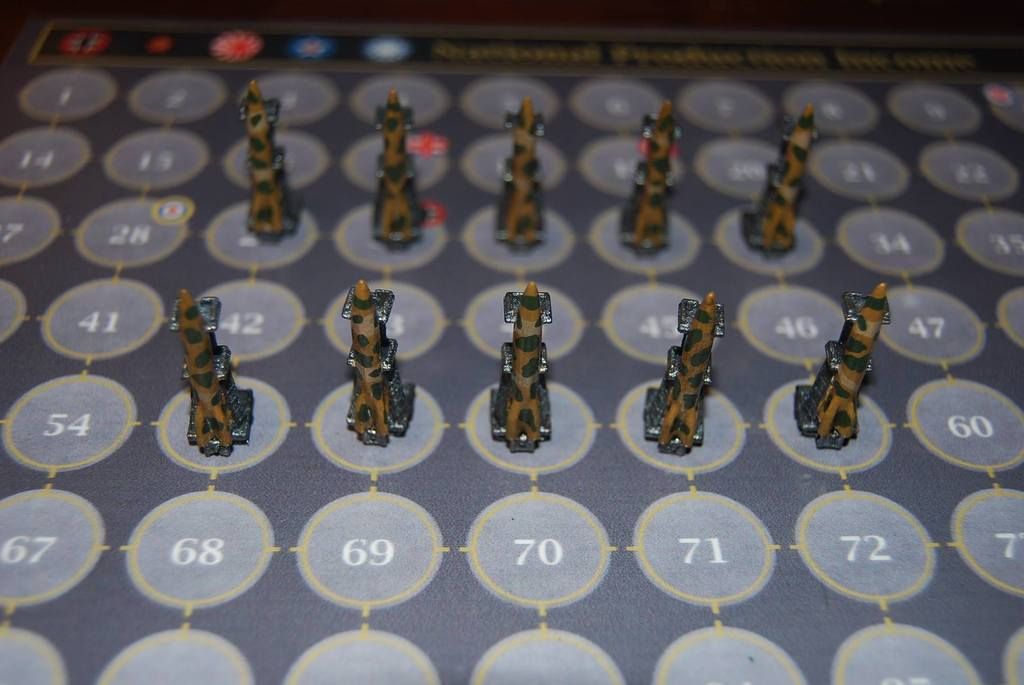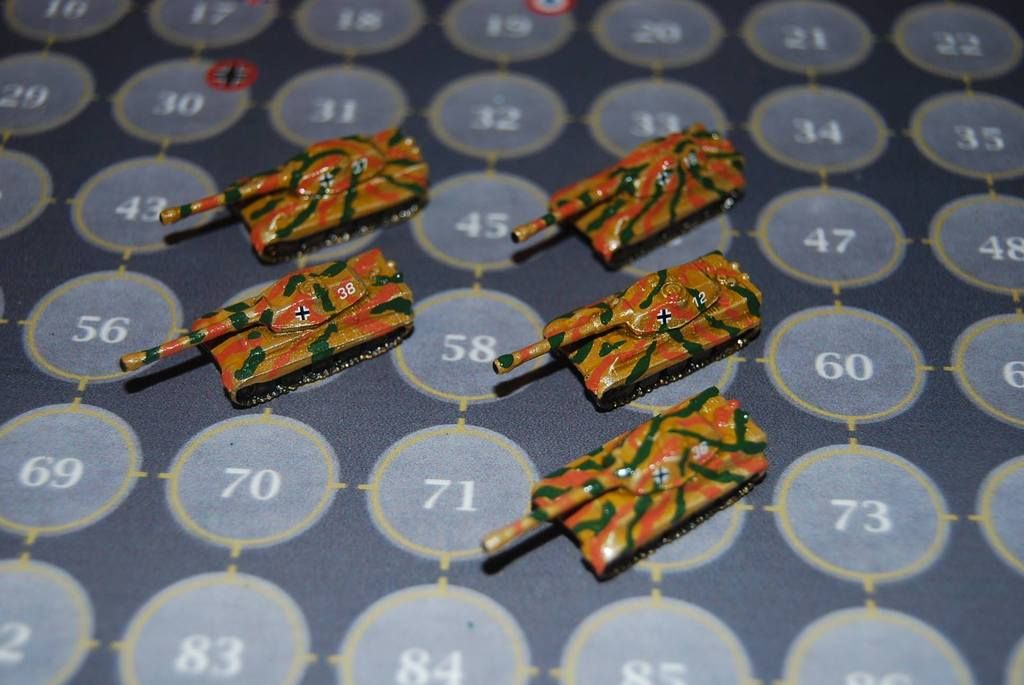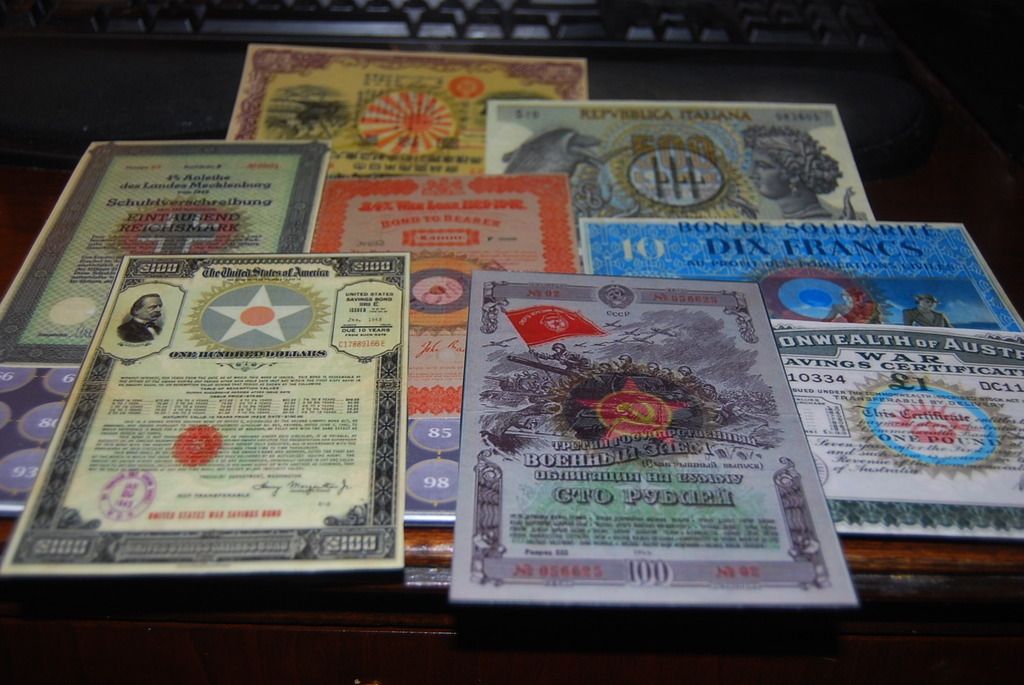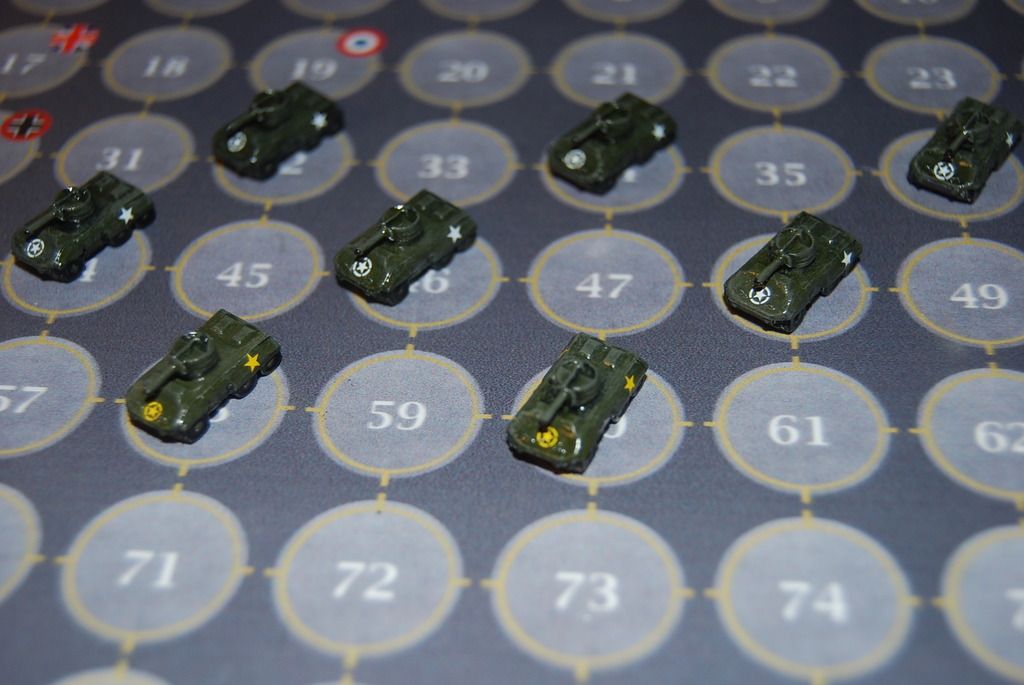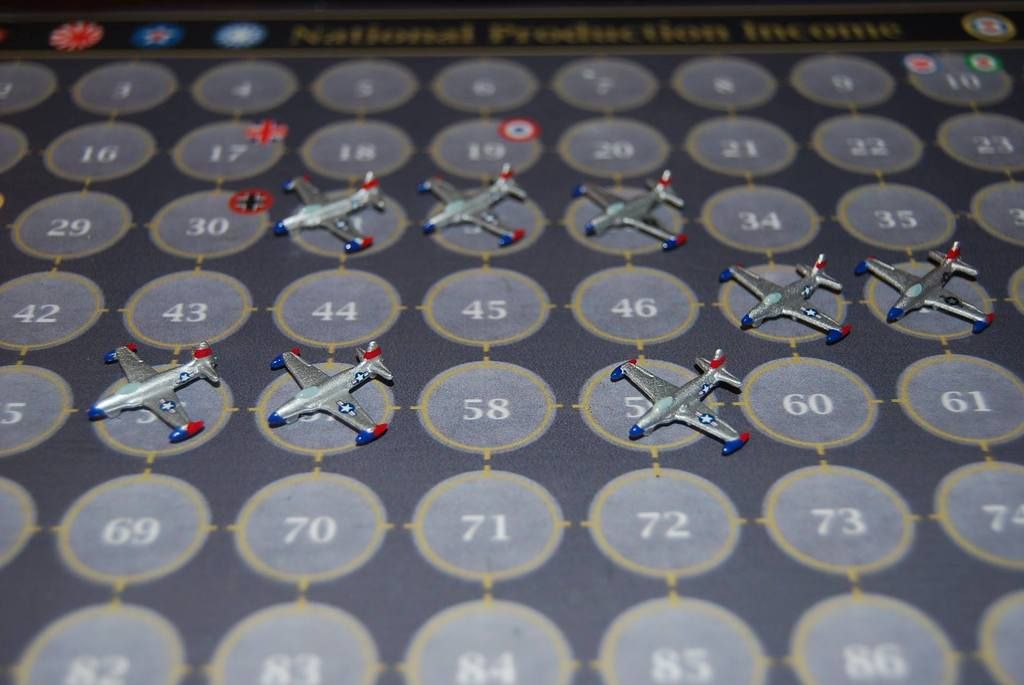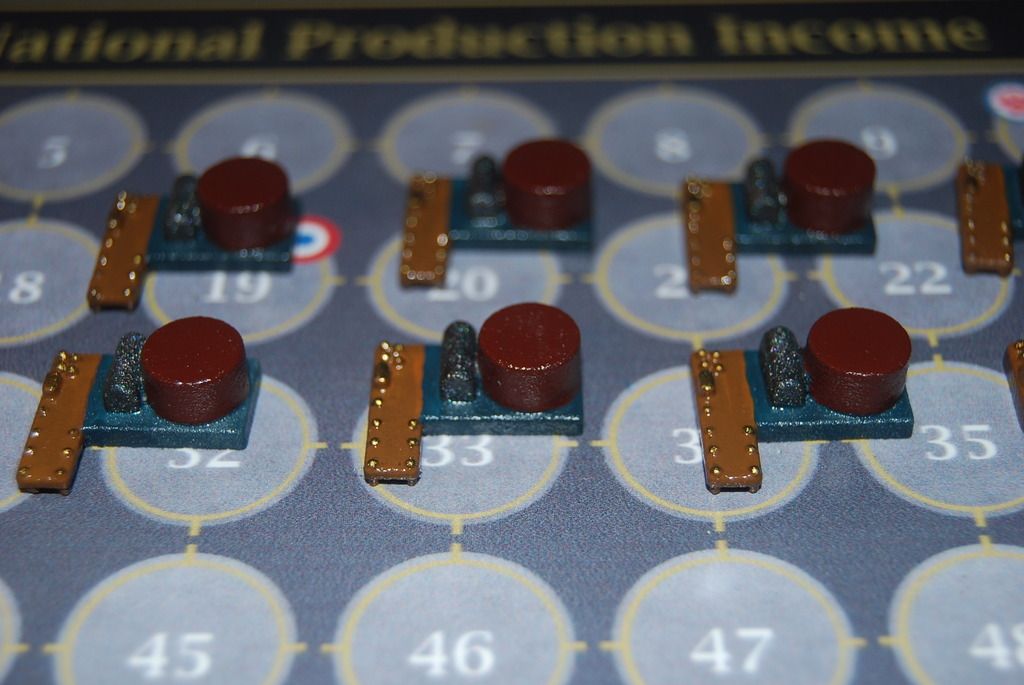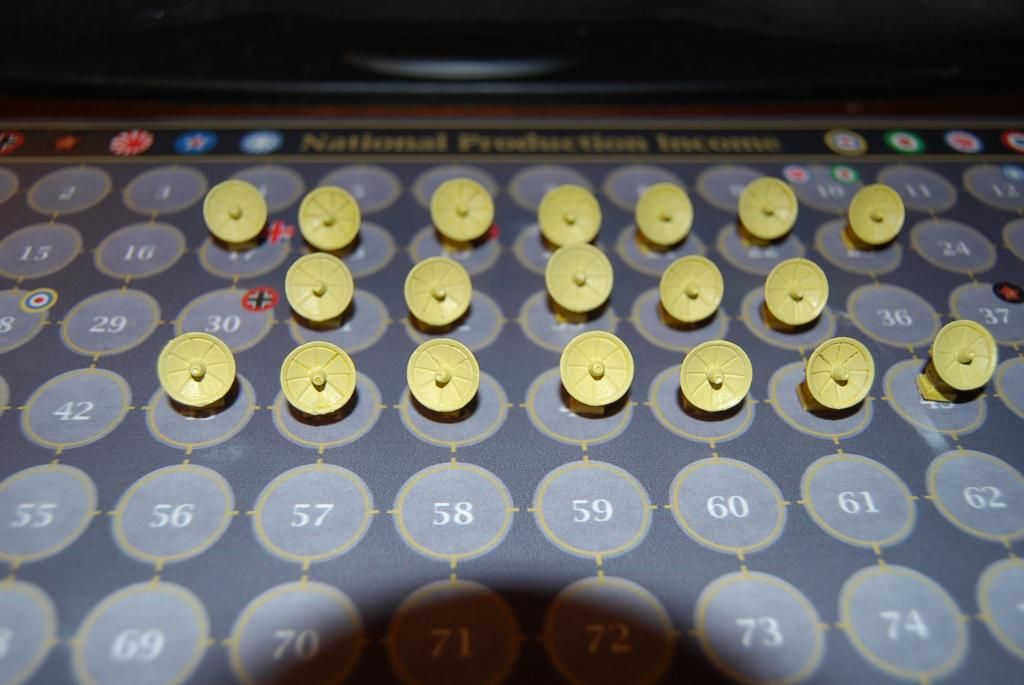Complicated rules start here:
These rules often require lots of paper (or a laptop) and quite a lot of experience with Axis and Allies in general.
Adding Zeppelins, Bombers, battle trains, armoured cars, torpedo boats, destroyers:
ALL these units listed here require the research rule.
Zeppelin: defenseless, cost 6IPCs
Characteristics:
Zeppelin bombing: during your battle move, you can move this unit into territory 3 spaces away. During the conduct combat phase, for 3 ammo, you can reduce territories IPC by 2. After your combat move phase and before you conduct combat phase, your opponent can move planes from adjacent territories to the territory that’s getting bombed. During combat, all these planes may roll and on a 1, they successfully shoot down the Zeppelin without it being able to bomb. On a two they manage to destroy it, but not before it are able to damage the territory. If the Zeppelin survives, it is able to return to the territory it started in.
E.g.: Germany decides to move a Zeppelin from Hanover to Picardy. Now Germany ends its movement phase. Now France decides that it’s going to move a plane from Paris and a plane from Belgium into Picardy. Now its Germanys conduct combat phase, the two French planes then roll a dice each, once French plane gets a 4 and the other a 3. The Zeppelin survives and deals two damage to Picardy, reducing its IPC value to 0. The Zeppelin then returns to Hanover.
Defenceless: Zeppelins are defenceless, and therefore will never roll dice. In battle, they cannot be taken as casualties until they are the last units remaining.
Zeppelins have a movement amount of 2. (3 if strategically bombing).
Torpedo boat: attack and defend at 1, cost 4IPCs
Characteristics:
None:
Destroyers: attack and defend at 2, cost 8 IPCs
Characteristics:
Sub-marine search and destroy: this unit can attack sub-marines for 1 more round of combat AFTER they have sub-merged and have effectively exited battle.
Note: this unit is largely useless and only useful when your enemies begin fielding large amount of subs.
Bomber: attack at 4 and defend at 1, cost 8 IPCs
Characteristics:
Strategic bombing: during your battle move, you can move this unit into territory 2 spaces away. During the conduct combat phase, for 2 ammo, you can reduce territories IPC by 1. After your combat move phase and before you conduct combat phase, your opponent can move planes from adjacent territories to the territory that’s getting bombed. During combat, all these planes may roll and on a 1, they successfully shoot down the Bomber without it being able to bomb. On a two they manage to destroy it, but not before it are able to damage the territory. If the Bomber survives, it is able to return to the territory it started in.
Defenceless during air supremacy: bombers do not roll dice for air supremacy, but they can be chosen for casualties and do create air supremacy battles even without friendly airplanes present. HOWEVER, bombers will only participate for the first round of combat, after that, they are considered to have bombed, and have returned to base. Therefore, after the first round of air supremacy, they roll a dice and kill on a 4 or less. Then they retreat to another adjacent friendly territory. If no territory can be provided, then this unit is destroyed.
Bombers can move 2 territories per turn.
Battle trains: attack and defends at 6IPCs
Characteristics:
Train unit: this unit uses up 1 railroad capacity every turn after the collect income phase, if no rail road capacity can be supplied. At this stage, players can also opt to destroy it.
This unit can move three spaces per turn.
Armoured car: attack and defends at 1, cost 5IPCs
Characteristics:
Transport: Armoured cars can allow two Infantry in the same territory to move two spaces that turn, IF they are moving into the same territory as this unit.
This unit can move two spaces per turn.
Adding Australia and Japan:
New nation: Australia/Japan (Auspan, Jastralia, Justpan, etc.)
This nation is considered to be ‘off board’. Therefore their territories and additional sea zones will need to be represented in some other way.
Australia/Japan has a total of 16 IPCs, and 3 Transport capacities.
Use Japanese and Australian units from A&A 1940 Pacific if possible, if not, then just find SOME way to tell them apart from the rest of the other units. (you could get some pieces of paper, right ‘Australia/Japan’ and place a little piece that you have another copy of (like a black pawn from a chess game) on it and the other on the board, thus representing the Australian/Japanese forces there).
Australia/Japans turn goes between Ottoman Empire and Italy.
Australia/Japan units that are built are considered to be 4 sea zones away.
Visual help:
Sea zone 29 sea zone 31 sea zone 32 sea zone 33 sea zone 34 Australia and Japan (16 IPCs) with a naval port leading into sea zone 34. So you would build a battleship on turn 1 in sea zone 34, then next turn you can move it into sea zone 32, and next turn you can move it into sea zone 29 (which is one the board, right next to India).
Adding dynamics to Italy
Italy is considered a neutral power throughout the game until it joins either the Allies or the Central powers.
While Italy is neutral, place 1 Infantry unit in Rome during Italy’s mobilise units phase. Since no one is controlling Italy until is joins a side, it means Italy will not purchase units on its own, move units on its own, or collect IPCs (EVER) on its own until its joins one of the sides. (However, they still go through all stages of a normal tern, AND their units can be moved when certain circumstances are met).
Italy’s setup remains unchanged, Italy’s Sea units are considered friendly to all powers, and therefore do not participate in any combat of any kind, while neutral.
Also, while playing with this rule, another sea zone is added which is intended to half the giant sea zone 17. This new sea zone is considered ‘sea zone 17.3 while the other is sea zone 17.6.
Sea zone 17.3 is connected to Piedmont, Tuscany, Sardinia, Sicily, Naples, Rome (and the naval base there), sea zone 17.6 and sea zone 16.
Sea zone 17.6 is connected to Sicily, Naples, Albania, Greece, Egypt, Libya, Sea zone 17.3, sea zone 16, sea zone 19, and sea zone 20.
For reference sake, draw a line between the very edges of Naples closest to Sicily, and draw a line from Sicily onto the edge of the nearby line of sea zone 16.
Get a piece of paper, write ‘ITALIAN ALLINING’ and:
Allies: -10 -9 -8 -7 -6 -5 -4 -3 -2 -1 0 1 2 3 4 5 6 7 8 9 10 11 12 13 14 15
Central powers: -10 -9 -8 -7 -6 -5 -4 -3 -2 -1 0 1 2 3 4 5 6 7 8
Get two Italian roundels and place 1 on ‘Allies -2’ and ‘Central powers +2’ at the start of the game.
Italy is considered neutral until one of the following happens:
Italy is attacked by central powers: join allies immediately
Italy is attacked by allies: join central power immediately
Italy has a total of 14 points difference between central powers and allied counters: they join the side that is in the positives. (e.g. allied has -8 and the Central powers have 8, that is a 16 point difference in the Central powers favour, therefore Italy joins the Central powers)
Note that this potentially means that Italy might not join the war all together.
Italy’s entrance into the war is/can be influenced by:
During a nations turn, it may choose to ‘influence’ Italy, thus, that nation can choose to either make Italy get a -1 on the enemy powers chart, or +1 to your own. EG: BEFORE Germanys ‘purchase units’ phase, Germany can choose to modify Italians entrance or not. If yes, then Germany can either force the Italian marker on the allies’ side to go down by 1, or make their own roundel go up by 1. Also, Britain and German get to modify it twice to represent the sheer amount of political involvement they had with Italy. Russia may not modify if they have surrendered (or gone into revolution). And U.S.A may not modify unless in the war.
For every 10 IPCs worth of units on the Italian border that belongs to the Central powers, +1 to the central powers Italian roundel. (Threatening military)
Giving Italy 6 IPCs, (THIS REQUIRES THE TRANSPORT CAPACITY RULE) players may choose to create an Italian convoy at their docks with 2 light chips under it during their purchase unit’s phase (and deploy it during mobilisation). These convoys are immediately absorbed by Italy during the Italian collect income phase, every time Italy takes a 6 IPC convoy, +1 to those sides Italian roundel.
Represent which side that created the convoy by using the red/blue chips under it. The convoy ship moves towards Rome via the shortest route every turn during Italy’s movement phase.
Every turn, as long as Austria-Hungary controls Tyrolia AND Trieste, -1 to Central powers Italian roundel.
+1 every turn to the allied Italian roundel if the allies control Tyrolia AND Trieste.
-3 to any power who attacks Albania. (E.g. if the central powers attack Albania, -3 to central powers Italian roundel).
+1 every turn towards the power that controls Switzerland. (Italy wants as small of a front as possible).
+1 towards the central powers for every allied nation that has surrendered/had its capital captured
During Italy’s turn, it will move units if:
There is a difference of +8 as the Central powers compared to the Allies, doing this means all Italian units on Venice move to Piedmont
There is a difference of +6 as the Allies compared to the Central powers, doing this means all Italian units on Piedmont move to Venice
Upon entering war:
If on the allies, then Italy is to be controlled by the Russian/U.S.A player, if on the central powers, it is controlled by the Ottoman Empire player. Italy conducts its turn separate just like every other power.
Italy works just like every other power, its purchases units, it moves and conducts combat, it collects income, it mobilises units ETC.
Adding dynamics to U.S.A
U.S.A works in a similar fashion to Italy, but instead of working out which sides it’s on; U.S.A works out when it will join the Allies. And the Kruger telegram.
Get a piece of paper and write:
U.S.A entrance chart:
–8 -7 -6 -5 -4 -3 -2 -1 0 1 2 3 4 5 6 7 8 9 10
Place a U.S.A roundel on 0
U.S.A is controlled by the Russian player.
U.S.A may not move any warships beyond sea zone 1.
U.S.A is not allowed to move any land units beyond sea zone 1 (physical convoy rule)
U.S.A CAN build convoy’s ship belonging to Britain (ONLY). (And because they belong to Britain and NOT the U.S.A, it means they can move past sea zone 1)
U.S.A will enter the war when:
Mexico attacks U.S.A via the Kruger telegram
When U.S.A reaches 10 on the U.S.A entrance chart
U.S.A gains IPCs based on the amount under the U.S.A roundel X2 (except when it’s in the negatives).
E.g. If U.S.A was on 4, and then U.S.A would gain 8 IPCs during their collect income stage.
This limit is removed and U.S.A gains is 20 IPCs when it enters the war
Things that influence U.S entry:
Every turn, move the roundel 1 space towards 0 IF the roundel is between -4 and 2
Every turn that Germany does unrestricted submarine warfare, move the roundel up 1
Whenever an ally influences Italy, move the U.S.A roundel down by 1
Every time a full-neutrals power is violated, +2 if central power, -2 if allied
Every time a central power aliened neutral joins the war, +1 if it joined by itself or when a central power nation moves units into it. -1 if it joined via the Allies attacking it.
+20 if attacked by a Central power
+12 if the Kruger telegram is intercepted
-20 if attacked by an allied power
If a CP declares it is using gas during a battle, +1
If an ally declares it is using gas during a battle, -1
Sending the Kruger telegram:
If the US is not at war, then Germany may send the Kruger telegram at any point during their turn.
Now roll three dice and add their scores together and use the chart below to see what happens:
3-5: Mexico agrees, U.S.A does not intercept, place 3 German Infantry and 1 Artillery in U.S.A.
6-8: Mexico agrees, U.S.A intercepts, place 3 German Infantry and 1 Artillery on U.S.A.
9-10: Mexico Denies, U.S.A does not intercept.
11-17: Mexico denies, U.S.A intercepts.
18: U.S.A is frenzied; place 3 German infantry and 1 artillery in U.S.A. If no central power unit occupies U.S.A during ANY nations purchase units phase, then increase U.S.As IPCs from 20 24 (representing U.S.A taking Mexico)
If Mexico (represented as German units) are unable to take U.S.A unless additional Central power units arrive. This prevents the awkward situation where Mexico is able to beat the US.






